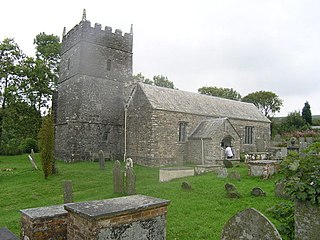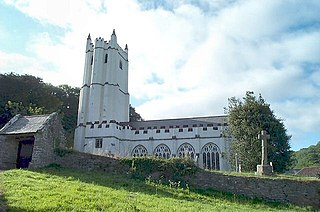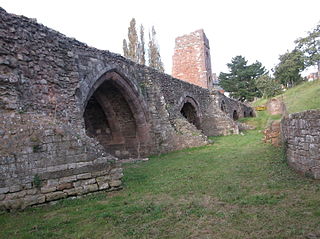
Dartington Hall in Dartington, near Totnes, Devon, England, is an historic house and country estate of 1,200 acres (4.9 km2) dating from medieval times. The group of late 14th century buildings are Grade I listed; described in Pevsner's Buildings of England as "one of the most spectacular surviving domestic buildings of late Medieval England", along with Haddon Hall and Wingfield Manor. The medieval buildings are grouped around a huge courtyard; the largest built for a private residence before the 16th Century, and the Great Hall itself is the finest of its date in England. The west range of the courtyard is regarded as nationally one of the most notable examples of a range of medieval lodgings. The medieval buildings were restored from 1926 to 1938.

Powderham Castle is a fortified manor house situated within the parish and former manor of Powderham, within the former hundred of Exminster, Devon, about 6 miles (9.7 km) south of the city of Exeter and 1⁄4 mile (0.4 km) north-east of the village of Kenton, where the main public entrance gates are located. It is a Grade I listed building. The park and gardens are Grade II* listed in the National Register of Historic Parks and Gardens.

St Peter's Church is a former Anglican church in the Preston Village area of Brighton, in the English city of Brighton and Hove. The 13th-century building, standing on the site of two older churches, was restored in the late 19th century and again after a serious fire in 1906. It was the parish church of Preston until 1908, when the newly built St John the Evangelist's Church gained this status. The Diocese of Chichester declared St Peter's redundant in 1990, and it is now owned by the Churches Conservation Trust. It has Grade II* listed status, reflecting its architectural and historical importance.

Various monasteries and other religious houses have existed at various times during the Middle Ages in the city of Exeter, Devon, England.

Old St John the Baptist's Church is a redundant Anglican church in the village of Pilling, Lancashire, England. It stands 100 metres (109 yd) to the south of the new church, also dedicated to St John the Baptist. The church is "an unusual survival of a small Georgian church". It is recorded in the National Heritage List for England as a designated Grade II* listed building, and it is under the care of the Churches Conservation Trust.

St Martin's Church is a redundant Anglican church in the village of Preston Gubbals, Shropshire, England. It is recorded in the National Heritage List for England as a designated Grade II* listed building, and is under the care of the Churches Conservation Trust.

The Church of St Nonna is a redundant church in Bradstone, Devon, England that was built in the 12th century. It is recorded in the National Heritage List for England as a designated Grade I listed building, and is in the care of the Churches Conservation Trust. It was vested in the Trust on 12 November 1996. The church is named after Saint Nonna.

St Petrock's Church in Parracombe, Devon, England was built in the 13th century. It is recorded in the National Heritage List for England as a designated Grade I listed building, and is now a redundant church in the care of the Churches Conservation Trust. It was declared redundant on 25 November 1969, and was vested in the Trust on 23 June 1971.

Holy Trinity Church in Torbryan, near Ipplepen in Devon, England, was built in the 15th century. It is recorded in the National Heritage List for England as a designated Grade I listed building, and is now a redundant church in the care of the Churches Conservation Trust. It was vested in the Trust on 1 July 1987.

St Peter's Church in Satterleigh, Devon, England was built in the 15th century. It is recorded in the National Heritage List for England as a designated Grade I listed building, and is now a redundant church in the care of the Churches Conservation Trust. It was vested in the Trust on 19 March 1996.

St James's Church in Luffincott, Devon, England was built in the 15th century. It is recorded in the National Heritage List for England as a designated Grade I listed building, and is now a redundant church in the care of the Churches Conservation Trust. It was declared redundant on 1 May 1975, and was vested in the Trust on 19 December 1979.

St Mary's Church in North Huish, Devon, England was built in the 14th century. It is recorded in the National Heritage List for England as a designated Grade I listed building, and is now a redundant church in the care of the Churches Conservation Trust. It was declared redundant on 1 March 1993, and was vested in the Trust on 10 August 1998.

The Church of St Peter the Poor Fisherman in the village of Noss Mayo, in Devon, England, was built in 1226. It is located in the former civil parish of Revelstoke. It is recorded in the National Heritage List for England as a designated Grade I listed building, and is a redundant church in the care of the Churches Conservation Trust. It was declared redundant on 6 April 1971, and was vested in the Trust on 28 June 1972.

St James' Church is a redundant Anglican church near the village of Stanstead Abbotts, Hertfordshire, England. It is recorded in the National Heritage List for England (NHLE) as a Grade I listed building, having been designated in 1967. The church is under the care of the Churches Conservation Trust. The church is about 1 mile (1.6 km) to the southeast of the village on the north side of the B181 road. It stands on the top of a hill overlooking the Lea marshes.

Highweek, less commonly called Highweek Village, in South Devon, England, is a parish, former manor and village, now a suburb of, and administered by, the town of Newton Abbot, but still retaining its village identity. It is prominent and recognisable due to its high location on a ridge on the north edge of the town. The area is the centre of the modern electoral ward of Bradley. Its population at the 2011 census was 5,043.

Monkleigh is a village, parish and former manor in north Devon, England, situated 2 1/2 miles north-west of Great Torrington and 3 1/2 miles south-east of Bideford. An electoral ward exists titled Monkleigh and Littleham. The population at the 2011 census was 1,488.

Martinhoe is a small settlement and civil parish in North Devon district of Devon, England. Martinhoe is within the Exmoor National Park, the smallest National Park in England. In the 2011 census Martinhoe Parish was recorded as having a population of 159. Martinhoe is in the Combe Martin ward, for elections to the district council. Martinhoe's local government takes the form of a parish meeting and as such has no parish council nor elected parish councillors.

The Church of St John the Baptist is the Anglican parish church for the village of Bishop's Tawton in Devon. The church has been a Grade I listed building since 1965 and comes under the Diocese of Exeter.

The Old Exe Bridge is a ruined medieval arch bridge in Exeter in south west England. Construction of the bridge began in 1190, and was completed by 1214. The bridge is the oldest surviving bridge of its size in England and the oldest bridge in Britain with a chapel still on it. It replaced several rudimentary crossings which had been in use sporadically since Roman times. The project was the idea of Nicholas and Walter Gervase, father and son and influential local merchants, who travelled the country to raise funds. No known records survive of the bridge's builders. The result was a bridge at least 590 feet long, which probably had 17 or 18 arches, carrying the road diagonally from the west gate of the city wall across the River Exe and its wide, marshy flood plain.




















